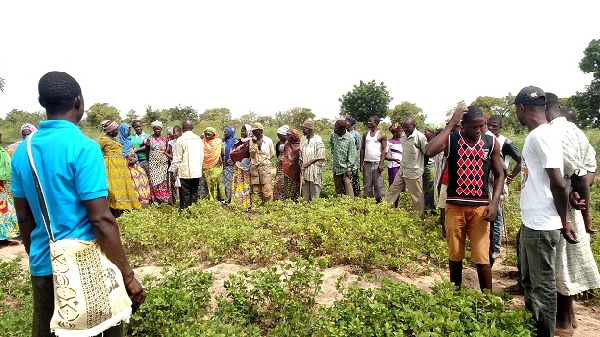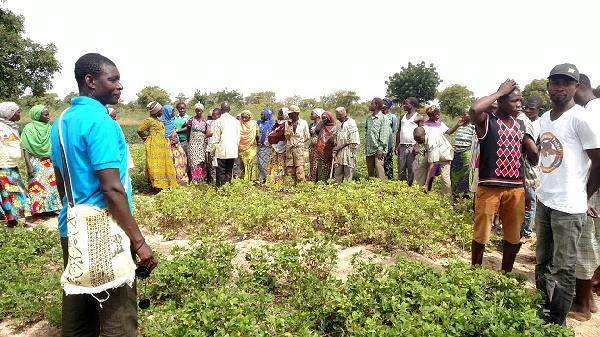Some smallholder farmers in the Upper West Region have been sensitized on quality peanut production and reduction of Aflatoxin for improved market.
About 22 new varieties have been introduced to farmers on a field day under the theme “promoting best management practices on groundnut production and reduction of aflatoxin contamination among smallholder farmers”.
Agriculture remains the engine of growth for most economies in the Sub-Saharan regions such as Ghana.
In Ghana, agriculture is the main source of food supplies for the large non-agricultural population and a source of raw materials to agro-based industries.
Commonly grown in semi-arid areas, peanuts/groundnuts serve as a source of both food and cash in regions of West Africa and are produced along with other major crops, such as maize, sorghum, yams and millet.
It is the world's fourth most important source of edible oil and third most important source of vegetable protein. Peanut is considered a women's crop in Africa, as it was originally grown by women to supplement their families' diet with protein to increase their nutrition level .
Research studies in Ghana revealed that farm yields for groundnut as well as for other major crops are considerably below achievable levels.
The poor performance in groundnut farming is attributed to lack of improved seeds, foliar diseases (peanut rosette and leaf spot), and poor pre- and post-harvest handling techniques that result in post-harvest losses and loss of nutritional value due to aflatoxin.
Aflatoxin in groundnut has become an issue of concern to many agro-business entities due to farmers’ inability to adhere to good agronomic practices to enhance quality production.
As a result, there is fear of a possible rejection should the Ghanaian peanut fail to meet the standards of the international market.
To increase groundnut production and reduce aflatoxin contamination among smallholder farmers, Peanut and Mycotoxin Innovation lab-USAID, has funded a project know as Using Applied Research and Technology Transfer to Minimize Aflatoxin Contamination and Increase Production, Quality and Marketing of Peanut in Ghana.
The aim is to reduce Aflatoxin and also in increase quality Peanut Production for a good market. The project started in October 2013 and ended in September 2017.

The goal of the project was to identify current practices involved in production, storage and processing of peanut that contributed to aflatoxin contamination and develop, implement and evaluate strategies to reduce aflatoxin contamination.
The objectives include to determine steps in the supply chain that was most vulnerable to development of aflatoxin and practice (s) that influenced aflatoxin contamination in peanut, (2) to carry out detailed comparisons of pest management, production, and field drying practices on aflatoxin contamination in peanut, and (3) to evaluate peanut germplasm for resistance to aflatoxin and other biotic stress factors such as leaf spot diseases.
It is against this background that, the project organized a field day at the CSIR- Savanna Agricultural Research Institute (SARI) experimental farm at Tanina in the Wa West District of the Upper West region where it introduces some 22 varieties of groundnuts to some selected smallholder farmers in the region to select from among the varieties to produce.
The field day was an opportunity to enable groups of farmers to meet together to get firsthand information on trials that were been carried out by the project.
The Co-Principal Investigator (PI) of the Peanut and Mycotoxin Innovation lab-USAID, Dr. George Yakubu Mahama of CSIR – SARI said best management practices such as use of improved varieties (naktiesari and yenywaso), timely weeding, application of recommended phosphorus fertilizer rates, control leaf spot diseases, and timely harvesting were key to improving groundnut yields.
The Co-Pi also advised farmers to dry their harvested groundnut on tarpaulin instead on bare ground to reduce aflatoxin contamination. He said the microorganism (fungi) that causes aflatoxin was soil bore, hence drying groundnut on the bare ground predispose the nuts to aflatoxin contamination.

In addition after drying, farmers were told to store their produce in improved hermetic bags on raise platforms.During the field day, the Co-Principal Investigator said a new proposal have been submitted to USAID for another phase of the project. During the new phase, the project will upscale all technologies developed during the previous project to cover the whole region.
Awareness is being created among farmers on best management practices for increase in groundnuts yields and measures in reducing aflatoxin contaminations among smallholder farmers in the Upper West region of Ghana as a result of this project.
A principal investigator of peanut and mycotoxin innovation laboratory of USAID and leader of the group at CSIR-SARI Nyankpala Dr Mumuni Abdulai who is also a principal research scientist and entomologist said the 3 regions of the north produce up to 92 per cent of total groundnuts in Ghana but added they have been a lot of challenges in production.
Dr Abdulai further revealed that groundnuts produced have a lot of millipedes, termites and warms feeding into the cobs of the groundnuts therefore increasing post-harvest losses and reducing nutrition of the produce.
He encouraged farmers to exercise good agronomic practices on their farms and also grow improved varieties of groundnuts such as Nkatia SARI which is resistance to leaf spot diseases.
He said Aflatoxin is a contaminant when affects groundnuts, it is not good for consumption.
A Socio-economist at the upper West Regional office CSIR- SARI Dr. Yahaya Iddrisu said farmers are not aware of what causes Aflatoxin therefore the idea is to introduce farmers to the causes of the contamination and how to reduce the Aflatoxin to enable them produce and sell at the international market.
The farmers in the Upper West Region appreciated the support from United States Agency for International Development (USAID) Bureau of Food Security (BFS) Washington.
A 46-year-old farmer from Tanina Paala-Naa Ishahaku said, marketing has always been a major challenge to farmers in the area. He said he did not know groundnuts had more than three varieties or even processing after harvest to reduce Aflatoxin Contamination.
Business News of Friday, 13 October 2017
Source: Yakubu Abdul-Gafur

















